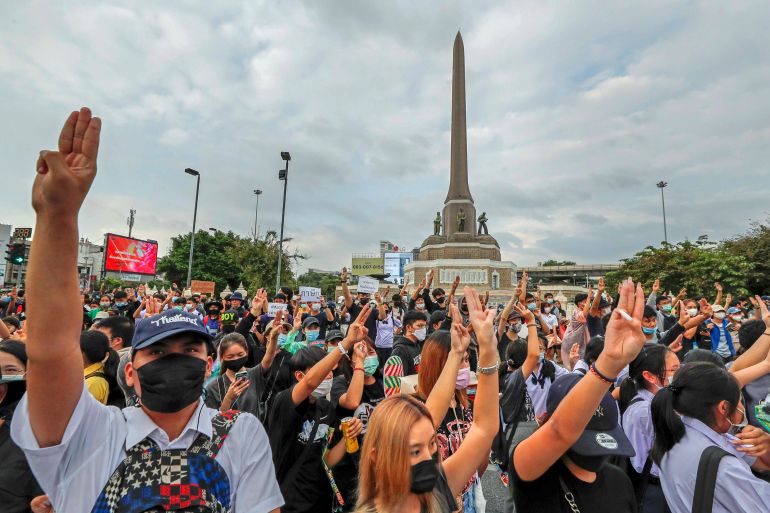The protests in Thailand are making history
For the first time in decades, people are openly defying the authority of the monarchy.

For days now, tens of thousands have taken to the streets of Bangkok to demand the resignation of General Prayuth Chan-ocha’s government, a new constitution and the legal, political, and economic reform of the Thai monarchy.
At the beginning of the summer, when this mobilisation started, the protest was mostly a student affair, organised through social media, with a focus on memes and political performances, and a harsh critique of the government’s performance.
Keep reading
list of 4 itemsPhotos: Thousands protest in Georgia over contentious ‘foreign agents’ bill
Pro-Palestinian protesters paralyse roads in US cities over war on Gaza
Lawmakers brawl as Georgian Parliament considers ‘foreign agent’ bill
The anger of this young generation, which grew up under the stranglehold of a military government, was initially directed against Prayuth. His government came to power through a coup d’état in 2014, won an election of questionable legitimacy in 2019, and failed to respond to an economic crisis that only worsened when the coronavirus pandemic hit.
Largely ignored by the authorities, the movement evolved and its demands began to change in August, when Panusaya Sithijirawattanakul, a 21-year-old student, read in front of a crowded square a document destined to make history.
“There was fear lurking inside me, deep fear of the consequences,” Panusaya told BBC News Thai, thinking back to the moments before going on stage. “I knew my life would never be the same again.”
Panusaya read a series of unprecedented demands: to take away the monarch’s legal immunity, to eliminate the lese-majeste law (which punishes any criticism of the monarchy with imprisonment), to cut the monarchy’s funds, to make its investments transparent and taxable, to prohibit members of the royal family from expressing political opinions, to suspend all forms of monarchic propaganda, to investigate the disappearance in recent years of various critics of the monarchy and to make it illegal for the monarch to support a coup d’état.
A public statement of this magnitude questioning the monarchy had not been heard in Thailand since the 1930s, when a group of young bureaucrats, who the young protesters today see as an inspiration, put an end to the absolute monarchy, with the support of large portions of the military forces. Today, instead, the military leadership are perched around the monarchy and see the preservation of its power as indispensable for the maintenance of their own. Based on this transformation and the legal consequences of any criticism of the monarchy, Panusaya’s fear was more than legitimate. Yet, it proved to be unfounded.
The 10 demands, instead of alienating supporters from the movement, galvanised it and broadened its base far beyond the students, attracting blue-collar workers, white-collar workers, people of various generations and social classes, including some former activists in the red shirts, a popular movement that had filled the streets of Bangkok in 2010 but remained largely dormant after the coup in 2014.
As a sign of this expansion, on October 14, tens of thousands of people stood in front of the government building asking for Prayuth’s resignation. The general, determined to let the protesters run out of steam without accepting their demands, responded the next day by declaring a state of emergency prohibiting any gathering of more than five people, arresting the leaders of the protest, including Panusaya, and threatening violent repression.
Today the protests continue, both in Bangkok and around the county, despite the emergency decree, the arrests, and the authorities’ intimidation techniques, which include reminding the protesters that anybody can die at any moment, discouraging them from trifling with Matjurat, the local deity of death, and attacking them with water cannon and tear gas.
Day by day, the protests are becoming more radical and direct in attacks against the monarch, who has now become, together with Prayuth, the main target of the mobilisation. Seen from abroad, this could seem like an obvious, and almost natural, conclusion of the last two decades of political struggle in Thailand in which the Thai monarchy has always taken the military’s side in the struggle between democratic and authoritarian forces. Yet, in the Thai context, this is an epochal change, a sudden and profound transformation that many people find hard to grasp.
During the demonstrations on October 14, seemingly as a provocation, the royal family drove through the protest and, for the first time in Thai history, their yellow Rolls-Royce was surrounded not by a cheering crowd but by hundreds of people shouting, insulting and reminding the royals that their car is paid for with people’s taxes.
The next day, during another protest in violation of the state of emergency imposed by Prayuth, thousands of people shouted insults out loud against the king, words that embarrassed local journalists who were forced to interrupt their live broadcast, record the same segments multiple times, or mute the background audio, in an awkward attempt not to broadcast them, due to the risk of being accused themselves of sedition or inciting unrest.
After a week of daily protests springing up across Bangkok and the rest of the country, what happens next is uncertain. Regardless of what the short-term consequences of these mobilisations will be, those verbal attacks against the monarch, which have become the new normal, represent an epochal shift for the country. It entails the surprising and sudden disintegration of monarchic hegemony, a political ideology that has dominated Thailand since the Cold War.
Now, much like the Berlin wall which once symbolised that cold conflict, the whole edifice of monarchical authority is coming down, reminding us that even a seemingly stable political structure can collapse at any moment.
The views expressed in this article are the author’s own and do not necessarily reflect Al Jazeera’s editorial stance.
